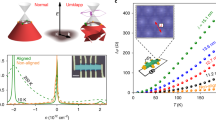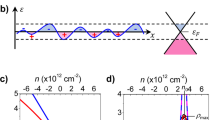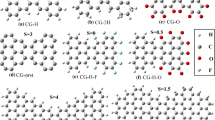Abstract
Nano-structured graphene has recently attracted extraordinary attention due to its potential use as an electronic or spintronic material. We investigated the electrical conductivities of antidot and Ar-sputtered graphene samples under a magnetic field in terms of the carrier density. Antidot samples exhibit conductivity that is well explained by charged impurity scattering, which is associated with intravalley scattering. This suggestion is supported by the low intensity of the Raman D band, which is related to intervalley scattering induced by structural defects. In contrast, Ar-sputtered samples show a strong D band and conductivity that is affected by defect scattering. The difference in the main scattering mechanism between the two types of samples appears as Shubnikov-de Haas oscillations at high magnetic fields, which are observed in antidot samples but not in Ar-sputtered samples. Furthermore, an analysis of weak localization effects in both samples at low fields reveals that intra- and intervalley scatterings play significant roles in antidot and Ar-sputtered samples, respectively.








Similar content being viewed by others
References
K.S. Novoselov, A.K. Geim, S.V. Morozov, D. Jiang, Y. Zhang, S.C. Dubonos, I.V. Grigorieva, and A.A. Firsov: Electric field effect in atomically thin carbon films. Science 306, 666 (2004).
K.S. Novoselov, A.K. Geim, S.V. Morozov, D. Jiang, M.I. Katsnelson, I.V. Grigorieva, S.V. Dubonos, and A.A. Firsov: Two-dimensional gas of massless Dirac fermions in graphene. Nature 438, 197 (2005).
Y. Zhang, Y.W. Tan, H.L. Stormer, and P. Kim: Experimental observation of the quantum Hall effect and Berry’s phase in graphene. Nature 438, 201 (2005).
K.I. Bolotin, K.J. Sikes, Z. Jiang, M. Klima, G. Fudenberg, J. Hone, P. Kim, and H.L. Stormer: Ultrahigh electron mobility in suspended graphene. Solid State Commun. 146, 351 (2008).
T. Ando: Screening effect and impurity scattering in monolayer graphene. J. Phys. Soc. Jpn. 75, 074716 (2006).
J.H. Chen, C. Jiang, S. Adam, M.S. Fuhrer, E.D. Williams, and M. Ishigami: Charged-impurity scattering in graphene. Nat. Phys. 4, 377 (2008).
T. Stauber, N.M.R. Peres, and F. Guinea: Electronic transport in graphene: A semiclassical approach including midgap states. Phys. Rev. B 76, 205423 (2007).
J.H. Chen, W.G. Cullen, C. Jang, M.S. Fuhrer, and E.D. Williams: Defect scattering in graphene. Phys. Rev. Lett. 102, 236805 (2009).
O.V. Yazyev and L. Helm: Defect-induced magnetism in graphene. Phys. Rev. B. 75, 125408 (2007).
K. Takai, H. Sato, T. Enoki, N. Yoshida, F. Okino, H. Touhara, and M. Endo: Effect of fluorination on nano-sized π-electron systems. J. Phys. Soc. Jpn. 70, 175 (2001).
J.H. Chen, L. Li, W.G. Cullen, E.D. Williams, and M.S. Fuhrer: Tunable Kondo effect in graphene with defects. Nat. Phys. 7, 535 (2011).
M. Fujita, K. Wakabayashi, K. Nakada, and K. Kusakabe: Peculiar localized state at zigzag graphite edge. J. Phys. Soc. Jpn. 65, 1920 (1996).
Y. Kobayashi, K. Fukui, T. Enoki, K. Kusakabe, and Y. Kaburagi: Observation of zigzag and armchair edges of graphite using scanning tunneling microscopy and spectroscopy. Phys. Rev. B 71, 193406 (2005).
Y. Niimi, T. Matsui, H. Kambara, K. Tagami, M. Tsukada, and H. Fukuyama: Scanning tunneling microscopy and spectroscopy studies of graphite edges. Appl. Surf. Sci. 241, 43 (2005).
T. Shen, Y.Q. Wu, M.A. Capano, L.P. Rokhinson, L.W. Engel, and P.D. Ye: Magnetoconductance oscillations in graphene antidot arrays. Appl. Phys. Lett. 93, 122102 (2008).
J. Bai, X. Zhong, S. Jiang, Y. Huang, and X. Duan: Graphene nanomesh. Nat. Nanotechnol. 5, 190 (2010).
X. Liang, Y.S. Jung, S. Wu, A. Ismach, D.L. Olynick, S. Cabrini, and J. Bokor: Formation of bandgap and subbands in graphene nanomeshes with sub-10 nm ribbon width fabricated via nanoimprint lithography. Nano Lett. 10, 2454 (2010).
M. Kim, N.S. Safron, E. Han, M.S. Arnold, and P. Gopalan: Fabrication and characterization of large-area, semiconducting nanoperforated graphene materials. Nano Lett. 10, 1125 (2010).
J. Eroms and D. Weiss: Weak localization and transport gap in graphene antidot lattices. New J. Phys. 11, 095021 (2009).
J. Moser, A. Barreiro, and A. Bachtold: Current-induced cleaning of graphene. Appl. Phys. Lett. 91, 163513 (2007).
L.G. Cançado, K. Takai, T. Enoki, M. Endo, Y.A. Kim, H. Mizusaki, A. Jorio, L.N. Coelho, R. Magalhães-Paniago, and M.A. Pimenta: General equation for the determination of the crystallite size La of nanographite by Raman spectroscopy. Appl. Phys. Lett. 88, 163106 (2006).
P. Blake, E.W. Hill, A.H.C. Neto, K.S. Novoselov, D. Jiang, R. Yang, T.J. Booth, and A.K. Geim: Making graphene visible. Appl. Phys. Lett. 91, 063124 (2007).
A.C. Ferrari, J.C. Meyer, V. Scardaci, C. Casiraghi, M. Lazzeri, F. Mauri, S. Piscanec, D. Jiang, K.S. Novoselov, S. Roth, and A.K. Geim: Raman spectrum of graphene and graphene layers. Phys. Rev. Lett. 97, 187401 (2006).
R. Saito, A. Jorio, A.G.S. Filho, G. Dresselhaus, M.S. Dresselhaus, and M.A. Pimenta: Probing phonon dispersion relations of graphite by double resonance Raman scattering. Phys. Rev. Lett. 88, 027401 (2002).
A.V. Baranov, A.N. Bekhterev, Y.S. Bobovich, and V.I. Petrov: Interpretation of certain characteristics in Raman spectra of graphite and glassy carbon. Opt. Spectrosc. 62, 612 (1987).
C. Thomsen and S. Reich: Double resonant Raman scattering in graphite. Phys. Rev. Lett. 85, 5214 (2000).
K. Sugihara: Thermoelectric power of graphite intercalation compounds. Phys. Rev. B 28, 2157 (1983).
L.G. Cançado, M.A. Pimenta, B.R.A. Neves, M.S.S. Dantas, and A. Jorio: Influence of the atomic structure on the Raman spectra of graphite edges. Phys. Rev. Lett. 93, 247401 (2004).
S. Heydrich, M. Hirmer, C. Preis, T. Korn, J. Eroms, D. Weiss, and C. Schüller: Scanning Raman spectroscopy of graphene antidot lattices: Evidence for systematic p-type doping. Appl. Phys. Lett. 97, 043113 (2010).
S.V. Morozov, K.S. Novoselov, M.I. Katsnelson, F. Schedin, D.C. Elias, J.A. Jaszczak, and A.K. Geim: Giant intrinsic carrier mobilities in graphene and its bilayer. Phys. Rev. Lett. 100, 016602 (2008).
S. Xiao, J.H. Chen, S. Adam, E.D. Williams, and M.S. Fuhrer: Charged impurity scattering in bilayer graphene. Phys. Rev. B 82, 041406 (2010).
R. Nouchi, M. Shiraishi, and Y. Suzuki: Transfer characteristics in graphene field-effect transistors with Co contacts. Appl. Phys. Lett. 93, 152104 (2008).
J.R. Hahn, H. Kang, S. Song, and I.C. Jeon: Observation of charge enhancement induced by graphite atomic vacancy: A comparative STM and AFM study. Phys. Rev. B 53, 1725 (1996).
K. Takai, Y. Nishimura, and T. Enoki: Anomalous magnetotransport in nanostructured graphene. Physica E 42, 680 (2010).
X. Zhang, Q.Z. Xue, and D.D. Zhu: Positive and negative linear magnetoresistance of graphite. Phys. Lett. A 320, 471 (2004).
E. McCann, K. Kechedzhi, V.I. Fal’ko, H. Suzuura, T. Ando, and B.L. Altshuler: Weak-localization magnetoresistance and valley symmetry in graphene. Phys. Rev. Lett. 97, 146805 (2006).
D.K. Ki, D. Jeong, J.H. Choi, H.J. Lee, and K.S. Park: Inelastic scattering in a monolayer graphene sheet: A weak-localization study. Phys. Rev. B 78, 125409 (2008).
F.V. Tikhonenko, D.W. Horsell, R.V. Gorbachev, and A.K. Savchenko: Weak localization in graphene flakes. Phys. Rev. Lett. 100, 056802 (2008).
J. Moser, H. Tao, S. Roche, F. Alzina, C.M.S. Torres, and A. Bachtold: Magnetotransport in disordered graphene exposed to ozone: From weak to strong localization. Phys. Rev. B 81, 205445 (2010).
B.R. Matis, F.A. Bulat, A.L. Friedman, B.H. Houston, and J.W. Baldwin: Giant negative magnetoresistance and a transition from strong to weak localization in hydrogenated graphene. Phys. Rev. B 85, 195437 (2012).
Acknowledgments
This work was supported by Grant-in-aid for Scientific Research no. 20001006 from the Ministry of Education, Culture, Sports, Science and Technology, Japan. This work was partly supported by MEXT Nanotechnology platform 12025014 (F-12-IT-0002).
Author information
Authors and Affiliations
Corresponding author
APPENDIX A
APPENDIX A
We used bilayer and monolayer graphenes for the antidot and Ar-sputtered samples. Monolayer graphene can be prepared easily for Ar-sputtered samples because the preparation process is simple. In contrast, we have seldom succeeded in the preparation and cleaning of monolayer antidot graphene because monolayer graphene is mechanically weak and chemically reactive. However, the electron-beam lithography technique allows the fabrication of antidots not only on the uppermost layer but also on the second layer as well, so that the characteristics of the antidots are almost the same for the first and second layers. Accordingly, we can treat these two layers as identical. Furthermore, as the physical processes that underlie the scattering are not significantly modified by the interlayer interaction, their essence is preserved. On the other hand, in the Ar-sputtered sample, bilayer graphene is inappropriate as defects created on the second layer are different from those on the uppermost layer because of differences in the penetration of the Ar ion. Thus, we chose bilayer antidot graphene and monolayer Ar-sputtered graphene to investigate the dominant scattering mechanism in each sample. In fact, the number of layers is not crucial to our analysis; our discussion focuses on the comparison of inter- and intravalley scattering sources.
Rights and permissions
About this article
Cite this article
Kudo, Y., Takai, K. & Enoki, T. Electron transport properties of graphene with charged impurities and vacancy defects. Journal of Materials Research 28, 1097–1104 (2013). https://doi.org/10.1557/jmr.2013.62
Received:
Accepted:
Published:
Issue Date:
DOI: https://doi.org/10.1557/jmr.2013.62




